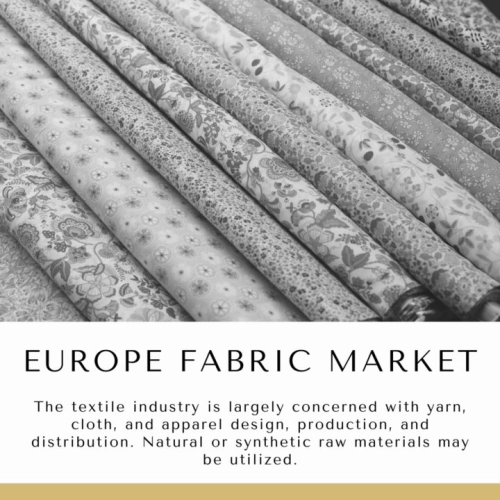
- Get in Touch with Us

Last Updated: Apr 25, 2025 | Study Period: 2022-2027
The textile industry is largely concerned with yarn, cloth, and apparel design, production, and distribution. Natural or synthetic raw materials may be utilized.
Cotton, jute, silk, kapok, hemp, and wool are all options for organic apparel. Organic clothing is becoming more popular as more people grow concerned about the environment.
Given the health and environmental benefits of organic products, more environmentally conscious people are turning to organic textiles for clothes.

The fashion industry is now taking new steps toward utilizing more sustainable textiles in response to customer demand and pressure to green its operations. Fast fashion behemoths are also embracing organic and recycled alternatives.
Fabric can be used to depict the basic framework of a building or a vehicle, as well as non-physical objects.
Fabric is most commonly used for clothing. Fabrics of some kind or combination are used to make every clothing. Fabric can be used to depict the basic framework of a building or a vehicle, as well as non-physical objects. You could argue that honesty is woven into the fabric of friendship, just as love is woven into the fabric of family. Something's foundation or essence is always fabric.
The Europe Fabric Market accounted for $XX Billion in 2021 and is anticipated to reach $XX Billion by 2027, registering a CAGR of XX% from 2022 to 2027.
YKK has released a new line of NATULON® recycled zippers that are constructed from ECONYL® regenerated nylon.
Carrington Textiles is demonstrating its dedication to workwear innovation by introducing revolutionary new fabrics at Techtextil.
Polartec®, a Milliken & Company brand and a leading provider of innovative and sustainable textile solutions, has announced a new collaboration with Browzwear, a pioneer in 3D digital fashion solutions. Users will be able to digitally design and create with Polartec's performance fabric collection, which is a first for the company.
fabric introduces a full-featured commerce platform for business buyers. Fabric, a headless commerce platform engineered for growth, has launched a B2B platform for distributors, manufacturers, and wholesalers who sell to other SMB, mid-market, and enterprise-scale businesses.
| Sl no | Topic |
| 1 | Market Segmentation |
| 2 | Scope of the report |
| 3 | Abbreviations |
| 4 | Research Methodology |
| 5 | Executive Summary |
| 6 | Introduction |
| 7 | Insights from Industry stakeholders |
| 8 | Cost breakdown of Product by sub-components and average profit margin |
| 9 | Disruptive innovation in the Industry |
| 10 | Technology trends in the Industry |
| 11 | Consumer trends in the industry |
| 12 | Recent Production Milestones |
| 13 | Component Manufacturing in US, EU and China |
| 14 | COVID-19 impact on overall market |
| 15 | COVID-19 impact on Production of components |
| 16 | COVID-19 impact on Point of sale |
| 17 | Market Segmentation, Dynamics and Forecast by Geography, 2022-2027 |
| 18 | Market Segmentation, Dynamics and Forecast by Product Type, 2022-2027 |
| 19 | Market Segmentation, Dynamics and Forecast by Application, 2022-2027 |
| 20 | Market Segmentation, Dynamics and Forecast by End use, 2022-2027 |
| 21 | Product installation rate by OEM, 2022 |
| 22 | Incline/Decline in Average B-2-B selling price in past 5 years |
| 23 | Competition from substitute products |
| 24 | Gross margin and average profitability of suppliers |
| 25 | New product development in past 12 months |
| 26 | M&A in past 12 months |
| 27 | Growth strategy of leading players |
| 28 | Market share of vendors, 2022 |
| 29 | Company Profiles |
| 30 | Unmet needs and opportunity for new suppliers |
| 31 | Conclusion |
| 32 | Appendix |